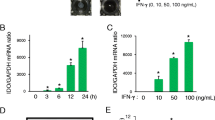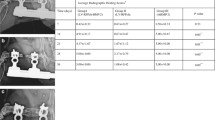Abstract
This study evaluated whether the murine leukemia virus (MLV)–based cyclooxygenase-2 (Cox-2) ex vivo gene-transfer strategy promotes healing of calvarial defects and/or synergistically enhances bone morphogenetic protein (BMP) 4–mediated bone regeneration. Gelatin scaffolds impregnated with mouse marrow stromal cells (MSCs) transduced with MLV-expressing BMP4, Cox-2, or a control gene were implanted into mouse calvarial defects. Bone regeneration was assessed by X-ray, dual-energy X-ray absorptiometry, and histology. In vitro, Cox-2 or prostanglandin E2 enhanced synergistically the osteoblastic differentiation action of BMP4 in mouse MSCs. In vivo, implantation of BMP4-expressing MSCs yielded massive bone regeneration in calvarial defects after 2 weeks, but the Cox-2 strategy surprisingly did not promote bone regeneration even after 4 weeks. Staining for alkaline phosphatase (ALP)–expressing osteoblasts was strong throughout the defect of animals receiving BMP2/4-expressing cells, but defects receiving Cox-2-expressing cells displayed weak ALP staining along the edge of original intact bone, indicating that the Cox-2 strategy lacked bone-regeneration effects. The Cox-2 strategy not only lacked bone-regeneration effects but also suppressed the BMP4-induced bone regeneration. In vitro coculture of Cox-2-expressing MSCs with BMP4-expressing MSCs in gelatin scaffolds reduced BMP4 mRNA transcript levels, suggesting that Cox-2 may promote BMP4 gene silencing in BMP4-expressing cells, which may play a role in the suppressive action of Cox-2 on BMP4-mediated bone formation. In summary, the Cox-2 ex vivo gene-transfer strategy not only lacks bone-regeneration effects but also suppresses the bone-regeneration action of BMP4 in healing of calvarial defects.






Similar content being viewed by others
References
Braithwaite RS, Col NF, Wong JB (2003) Estimating hip fracture morbidity, mortality and costs. J Am Geriatr Soc 51:364–370
Schmidmaier G, Schwabe P, Strobel C, Wildemann B (2008) Carrier systems and application of growth factors in orthopaedics. Injury 39(Suppl 2):S37–S43
Lieberman JR, Daluiski A, Einhorn TA (2002) The role of growth factors in the repair of bone. Biology and clinical applications. J Bone Joint Surg Am 84:1032–1044
Simpson AH, Mills L, Noble B (2006) The role of growth factors and related agents in accelerating fracture healing. J Bone Joint Surg Br 88:701–705
Kanakaris NK, Giannoudis PV (2008) Clinical applications of bone morphogenetic proteins: current evidence. J Surg Orthop Adv 17:133–146
Barnes GL, Kakar S, Vora S, Morgan EF, Gerstenfeld LC, Einhorn TA (2008) Stimulation of fracture-healing with systemic intermittent parathyroid hormone treatment. J Bone Joint Surg Am 90(Suppl 1):120–127
Dereka XE, Markopoulou CE, Vrotsos IA (2006) Role of growth factors on periodontal repair. Growth Factors 24:260–267
Sanchez M, Anitua E, Cugat R, Azofra J, Seijas R, Andia I (2009) Nonunions treated with autologous preparation rich in growth factors. J Orthop Trauma 23:52–59
Luginbuehl V, Meinel L, Merkle HP, Gander B (2004) Localized delivery of growth factors for bone repair. Eur J Pharm Biopharm 58:197–208
Jones CB, Sabatino CT, Badura JM, Sietsema DL, Marotta JS (2008) Improved healing efficacy in canine ulnar segmental defects with increasing recombinant human bone morphogenetic protein-2/allograft ratios. J Orthop Trauma 22:550–559
Hafeman AE, Li B, Yoshii T, Zienkiewicz K, Davidson JM, Guelcher SA (2008) Injectable biodegradable polyurethane scaffolds with release of platelet-derived growth factor for tissue repair and regeneration. Pharm Res 5:2387–2399
Klamut HJ, Chen S-T, Lau K-HW, Baylink DJ (2004) Progress toward skeletal gene therapy. Crit Rev Eukaryotic Gene Exp 14:89–136
Shen FH, Visger JM, Balian G, Hurwitz SR, Diduch DR (2002) Systemically administered mesenchymal stromal cells transduced with insulin-like growth factor-I localize to a fracture site and potentiate healing. J Orthop Trauma 16:651–659
Franceschi RT, Wang D, Krebsbach PH, Rutherford RB (2000) Gene therapy for bone formation: in vitro and in vivo osteogenic activity of an adenovirus expressing BMP7. J Cell Biochem 78:476–486
Betz OB, Betz VM, Nazarian A, Egermann M, Gerstenfeld LC, Einhorn TA, Vrahas MS, Bouxsein ML, Evans CH (2007) Delayed administration of adenoviral BMP-2 vector improves the formation of bone in osseous defects. Gene Ther 14:1039–1044
Tarkka T, Sipola A, Jämsä T, Soin Y, Ylä-Herttuala S, Tuukkanen J, Hautala T (2003) Adenoviral VEGF-A gene transfer induces angiogenesis and promotes bone formation in healing osseous tissues. J Gene Med 5:560–566
Shen HC, Peng H, Usas A, Gearhart B, Fu FH, Huard J (2004) Structural and functional healing of critical-size segmental bone defects by transduced muscle-derived cells expressing BMP4. J Gene Med 6:984–991
Rundle CH, Miyakoshi N, Kasukawa Y, Chen S-T, Sheng MH-C, Wergedal JE, Lau K-HW, Baylink DJ (2003) In vivo bone formation in fracture repair by direct retroviral-based gene therapy with BMP-4. Bone 32:591–601
Gysin R, Wergedal JE, Sheng MH-C, Kasukawa Y, Miyakoshi N, Chen S-T, Peng H, Lau K-HW, Mohan S, Baylink DJ (2002) Ex vivo gene therapy with stromal cells transduced with a retroviral vector containing the BMP4 gene completely heals critical size calvarial defect in rats. Gene Ther 9:991–999
Rundle CH, Strong DD, Chen S-T, Linkhart TA, Sheng M-HC, Wergedal JE, Lau K-HW, Baylink DJ (2008) Retroviral-based gene therapy with cyclooxygenase-2 promotes the union of bony callus tissues and accelerates fracture healing in the rat. J Gene Med 10:229–241
Zhang XS, Linkhart TA, Chen S-T, Peng H, Wergedal JE, Guttierez GG, Sheng MH-C, Lau K-HW, Baylink DJ (2004) Local ex vivo gene therapy with bone marrow stromal cells expressing human BMP4 promotes endosteal bone formation in mice. J Gene Med 6:4–15
Bolander ME (1992) Regulation of fracture repair by growth factors. Proc Soc Exp Biol Med 200:165–170
Abe E, Yamamoto M, Taguchi Y, Lecka-Czernik B, O’Brien CA, Economides AN, Stahl N, Jilka RL, Manolagas SC (2000) Essential requirement of BMPs-2/4 for both osteoblast and osteoclast formation in murine bone marrow cultures from adult mice: antagonism by noggin. J Bone Miner Res 15:663–673
Wozney JM, Rosen V (1998) Bone morphogenetic protein and bone morphogenetic protein gene family in bone formation and repair. Clin Orthop 346:26–37
Peng H, Wright V, Usas A, Gearhart B, Shen HC, Cummins J, Huard J (2002) Synergistic enhancement of bone formation and healing by stem cell-expressed VEGF and bone morphogenetic protein-4. J Clin Invest 110:751–759
Peng H, Usas A, Olshanski A, Ho AM, Gearhart B, Cooper GM, Huard J (2005) VEGF improves, whereas sFlt1 inhibits, BMP2-induced bone formation and bone healing through modulation of angiogenesis. J Bone Miner Res 20:2017–2027
Simon AM, Manigrasso MB, O’Connor JP (2002) Cyclo-oxygenase 2 function is essential for bone fracture healing. J Bone Miner Res 17:963–976
Zhang X, Schwarz EM, Young DA, Puzas JE, Rosier RN, O’Keefe RJ (2002) Cyclooxygenase-2 regulates mesenchymal cell differentiation into the osteoblast lineage and is critically involved in bone repair. J Clin Invest 109:1405–1415
Kawaguchi H, Pilbeam CC, Harrison JR, Raisz LG (1995) The role of prostaglandins in the regulation of bone metabolism. Clin Orthop 313:36–46
Klenke FM, Gebhard MM, Ewerbecj V, Abdollahi A, Huber PE, Sckell A (2006) The selective Cox-2 inhibitor celecoxib suppresses angiogenesis and growth of secondary bone tumors: an intravital microscopy study in mice. BMC Cancer 6:9
Carvalho RS, Einhorn TA, Lehmann W, Edgar C, Al-Yamani A, Apazidis A, Pacicca D, Clemens TL, Gerstenfeld LC (2004) The role of angiogenesis in a murine tibial model of distraction osteogenesis. Bone 34:849–861
Rundle CH, Chen S-T, Porte R, Wergedal JE, Lau K-HW (2008) Retroviral-based BMP-4 in vivo gene transfer strategy with intramedullary viral delivery optimizes transgene expression in rat femur fractures. Open Tiss Eng Regen Med J 1:14–22
Peng H, Chen S-T, Wergedal JE, Polo JM, Yee J-K, Lau K-HW, Baylink DJ (2001) Development of an MFG-based retroviral vector system for high secretion of functionally active human BMP-4. Mol Ther 4:95–104
Livak KJ, Schmittgen TD (2001) Analysis of relative gene expression data using real-time quantitative PCR and the 2 −ΔΔCT method. Methods 25:402–408
Farley JR, Hall SL, Herring S, Tarbaux NM (1992) Two biochemical indices of mouse bone formation are increased, in vivo, in response to calcitonin. Calcif Tissue Int 50:67–73
Farley JR, Baylink DJ (1986) Skeletal alkaline phosphatase activity as a bone formation index in vitro. Metabolism 35:563–571
Gram GJ, Nielsen SD, Hansen JE (1998) Spontaneous silencing of humanized green fluorescent protein (hGFP) gene expression from a retroviral vector by DNA methylation. J Hematother 7:333–341
Keila S, Kelner A, Weinreb M (2001) Systemic prostaglandin E2 increases cancellous bone formation and mass in aging rats and stimulates their bone marrow osteogenic capacity in vivo and in vitro. J Endocrinol 168:131–139
Keller J (1996) Effects of indomethacin and local prostaglandin E2 on fracture healing in rabbits. Dan Med Bull 43:317–329
Komuro Y, Akizuki T, Kurakata M, Ohmori K (1999) Histological examination of regenerated bone through craniofacial bone distraction in clinical studies. J Craniofac Surg 10:308–311
Xu Z, Choudhary S, Voznesensky O, Mehrotra M, Woodard M, Hansen M, Herschman H, Pilbeam C (2006) Overexpression of Cox-2 in human osteosarcoma cells decreases proliferation and increases apoptosis. Cancer Res 66:6657–6664
Choudhary S, Huang H, Raisz L, Philbeam C (2008) Anabolic effects of PTH in cyclooxygenase-2 knockout osteoblasts in vitro. Biochem Biophys Res Commun 372:536–541
Li X, Zhang Y, Kang H, Liu W, Liu P, Zhang J, Harris SE, Wu D (2005) Sclerostin binds to LRP5/6 and antagonizes canonical Wnt signaling. J Biol Chem 280:19883–19887
Suda N, Baba O, Udagawa N, Terashima T, Kitahara Y, Takano Y, Kuroda T, Senior PV, Beck F, Hammond VE (2001) Parathyroid hormone–related protein is required for normal intramembranous bone development. J Bone Miner Res 16:2182–2191
ten Dijke P, Krause C, de Gorter DJ, Löwik CW, van Bezooijen RL (2008) Osteocyte-derived sclerostin inhibits bone formation: its role in bone morphogenetic protein and Wnt signaling. J Bone Joint Surg Am 90(Suppl 1):31–35
Swindle CS, Kim HG, Klug CA (2004) Mutation of CpGs in the murine stem cell virus retrovial vector long terminal repeat represses silencing in embryonic stem cells. J Biol Chem 279:34–41
Pannell D, Ellis J (2001) Silencing of gene expression: implications for design of retrovirus vectors. Rev Med Virol 11:205–217
Paralkar VM, Grasser WA, Mansolf AL, Baumann AP, Own TA, Smock SL, Martinovic S, Borovecki F, Vukicevic S, Ke HZ, Thompson DD (2002) Regulation of BMP-7 expression by retinoic acid and prostaglandin E2. J Cell Physiol 190:207–217
Acknowledgements
This work was supported by a special appropriation to the Jerry L. Pettis Memorial VA Medical Center, Musculoskeletal Disease Center, and by an Assistance Award from the United States Army (DAMD-17-03-2-0021). The United States Army Medical Research Acquisition Activity (820 Chandler Street, Fort Detrick, MD 21702-5014) is the awarding and administering acquisition office. The information contained in this publication does not necessarily reflect the position or policy of the government, and no official endorsement should be inferred. All work was performed in facilities provided by the Department of Veterans Affairs.
Author information
Authors and Affiliations
Corresponding author
Rights and permissions
About this article
Cite this article
Lau, KH.W., Gysin, R., Chen, ST. et al. Marrow Stromal Cell-Based Cyclooxygenase 2 Ex Vivo Gene-Transfer Strategy Surprisingly Lacks Bone-Regeneration Effects and Suppresses the Bone-Regeneration Action of Bone Morphogenetic Protein 4 in a Mouse Critical-Sized Calvarial Defect Model. Calcif Tissue Int 85, 356–367 (2009). https://doi.org/10.1007/s00223-009-9282-2
Received:
Accepted:
Published:
Issue Date:
DOI: https://doi.org/10.1007/s00223-009-9282-2




